The 1979 Penny is also a Lincoln Memorial Penny, originally introduced in 1959 to celebrate the 150th anniversary of Abraham Lincoln’s birth. Nearly 20 years later, the 1979 Penny gained attention partly due to the popularity of the newer, smaller dollar coin at that time. Let’s explore the value of the 1979 Penny and understand why it remains notable.
1979 Penny Value Chart
| Coin | MS 65 | MS 66+ | MS 67+ | MS 68 | PR/PF 69 DCAM | PR/PF 70 DCAM |
|---|---|---|---|---|---|---|
| 1979 No Mint Mark Penny | $18 | $55 | $275 | $2,650 | – | – |
| 1979-D Penny | $28 | $75 | $3,950 | – | – | – |
| 1979-S Filled-S Proof Penny | – | – | – | – | $20 | $2,750 |
| 1979-S Clear-S Proof Penny | – | – | – | – | $22 | $1,350 |
History of the 1979 Penny

Collectible coins are a significant source of revenue for the U.S. Mint. They are usually sold as Mint Sets, Proof Sets, or Uncirculated Sets, each containing one coin from every circulating denomination. There are also PDS Sets, which include one coin from each mint branch. These annual sets increase production especially in years when new coins are introduced, such as the Susan B. Anthony Dollar in 1979.
The public’s interest in the newest designs also sparks curiosity about collecting other coins from the same year, which helped boost attention to the 1979 Lincoln Cent. Another factor made this penny stand out: in the 1960s, silver prices soared, leading people to hoard coins. The Mint responded by producing coins without silver content, using cupronickel instead.
These post-1965 coins had a copper core with outer layers made from the nickel formula (75% copper and 25% nickel). However, in the 1970s, copper prices began rising sharply as well. At that time, the penny was the Mint’s most profitable coin, but the metal’s spot price exceeded the coin’s face value, causing losses for the Mint.
Copper Prices Impact the Penny
To address this issue, the Mint experimented with different metal compositions for the Lincoln Cent, including more than one million aluminum cents minted in 1973. These were mostly rejected and destroyed, though a few survived and now appear in private collections. To allow for changes, Congress passed a law in 1974 permitting zinc penny production at will.
When copper prices spiked again in 1981, the Mint settled in 1982 on a composition of 97.5% zinc with a thin 2.5% copper coating. These pennies were lighter and cheaper to produce. This formula kept the Mint profitable for a while, but in 2023 it costs almost 3 cents to make a single penny, resulting in losses again. Despite this, pennies remain popular and continue to circulate.
About the 1979 Penny
As mentioned, the 1979 penny benefited from the attention around the 1979 SBA dollar. Plus, with rising copper prices in 1981 and the introduction of the new metal composition in 1982, many collectors hoarded copper pennies from earlier years, like 1979, making high-grade examples easier to find.
The 1979 Proof Penny was minted in two styles, depending on the mint mark.
Features of the 1979 Penny
The Obverse of the 1979 Penny
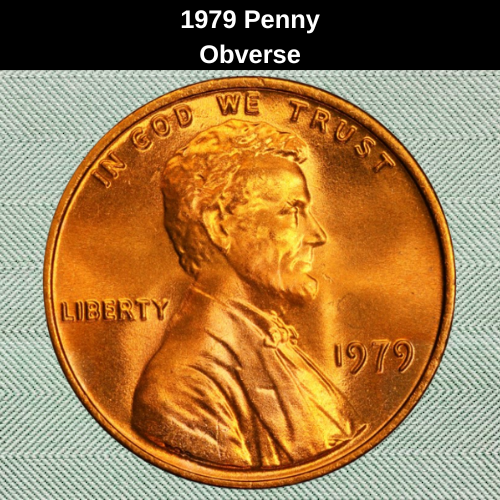
The obverse of the coin features Abraham Lincoln, the 16th President of the United States. He’s depicted facing to the right. Above his head is the national motto, “In God We Trust.” Behind his back, along the left edge of the coin, appears the word “Liberty.” The date of minting is positioned in front of Lincoln’s chest, and just below the date is the mint mark (if present). At the base of Lincoln’s shoulder, you’ll find the initials VDB, which stand for Victor David Brenner, the designer of the coin.
The Reverse of the 1979 Penny
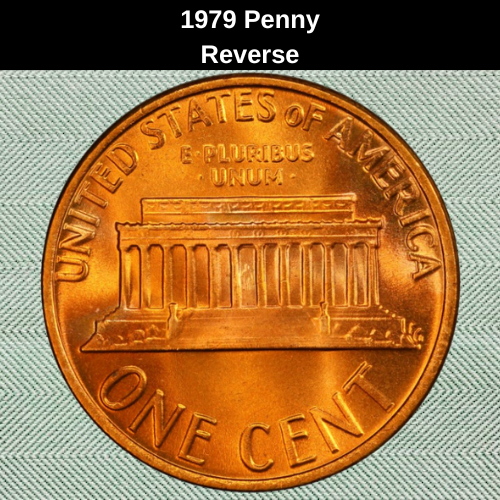
The reverse of the 1979 penny features the Lincoln Memorial, with a view of Lincoln’s statue visible through the two central columns. At the top of the coin, the inscription reads “United States of America”, and below that is the national motto, “E Pluribus Unum.” At the bottom, the denomination “One Cent” is displayed. In the lower-right corner of the memorial’s steps, you’ll find the initials FG, which stand for Frank Gasparro, the coin’s designer.
Other Features of the 1979 Penny
This penny has a smooth, plain edge (without reeds), a diameter of 19.05mm (0.75”), and a weight of 3.11g. The coin is composed of 95% copper and 5% zinc, a metal composition that would change in the years following 1982. Due to rising copper prices, the mint switched the composition to 97.5% zinc and 2.5% copper.
1979 Penny Grading
Pennies have a distinctive copper hue, so in addition to the standard Sheldon Scale, they also receive color designations that reflect the condition of their surface toning. The Sheldon Scale ranges from Poor (PO 1) all the way up to Mint State (MS 70).
In some grading systems, “Uncirculated” refers to grades AU 50 to AU 58, while others treat it as equivalent to Mint State. For Lincoln cents, especially copper-based coins like the 1979 penny, an additional layer of grading identifies color condition:
- RD (Red): Over 95% of the original red luster remains.
- RB (Red-Brown): Between 5% and 95% of the red luster remains.
- BN or BRN (Brown): Less than 5% of the red luster remains.
Sheldon Grading Scale Summary:
| Grade | Description |
|---|---|
| 1 | Basal State-1 (Poor) |
| 2 | Fair |
| 3 | Very Fair |
| 4–6 | Good |
| 7–10 | Very Good |
| 12–15 | Fine |
| 20–30 | Very Fine |
| 40 | Extremely Fine |
| 50 | About Uncirculated |
| 60 | Mint State (MS 60) |
| 65 | Mint State (MS 65) |
| 70 | Perfect Mint State |
To determine the exact value of your 1979 penny, it’s essential to understand both its grade and color classification. For more details, please consult our grading guides, which explain how to assess both the Sheldon scale and color ratings accurately.
1979 Penny Value Guides
1979 No-Mint-Mark Penny Value
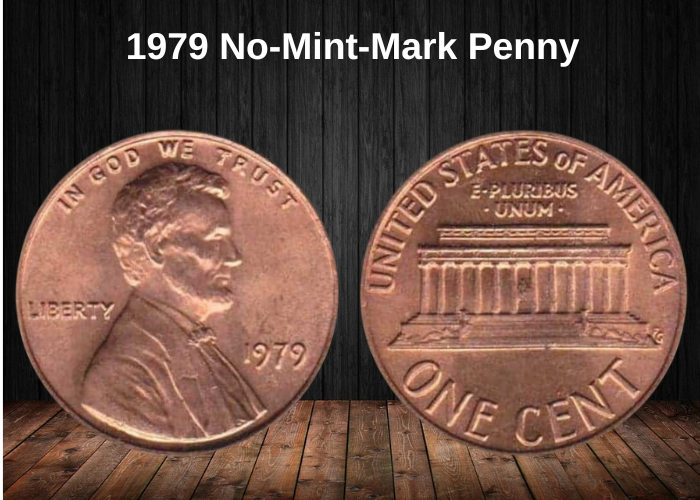
In 1979, the U.S. Mint struck 6,018,515,000 Lincoln Cents without a mint mark. While these are commonly attributed to the Philadelphia Mint, the reality is a bit more complex:
- 1,705,850,000 coins were minted at West Point
- 751,725,000 coins came from San Francisco
Despite their origin, all these coins were regular business strikes, meaning they were produced for everyday circulation—not for collectors.
As a result, most examples aren’t particularly rare or valuable in lower grades. However, high-grade coins can command impressive prices:
- In February 2007, a Brown (BN) 1979 cent graded MS 61 sold for $207.
- Red (RD) examples perform significantly better. One graded MS 68 RD sold for $5,463 in 2012.
- As of August 2023, with a dozen MS 68 RD coins graded by PCGS, the estimated value has dropped to around $2,000.
- Lower grades have more submissions and lower values:
- MS 66+ RD (only 5 known): around $46
- MS 67 RD (200+ graded): about $120
- MS 67+ RD (12 graded): approximately $425
These numbers show how color designation and grade rarity directly affect the market value of 1979 Lincoln cents, especially those without a mint mark.
1979-D Penny Value
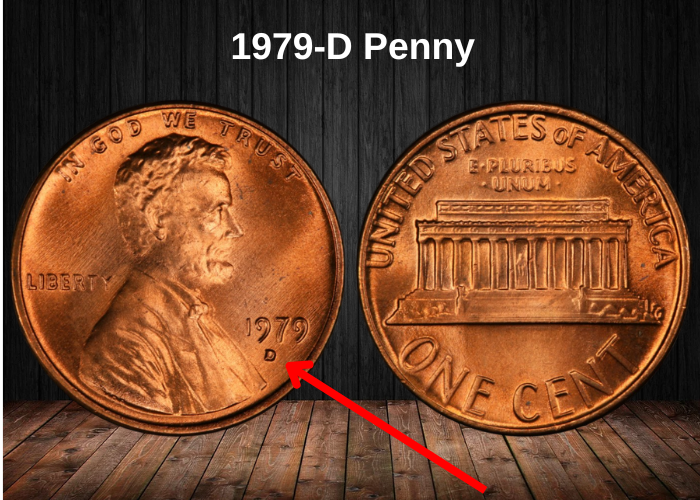
In 1979, the Denver Mint struck an impressive 4,139,357,254 Lincoln Cents for circulation. These coins bear the “D” mint mark and were standard business strikes intended for everyday use.
Despite their large mintage, high-grade examples can still fetch notable prices:
- In October 2019, an MS 66 Brown (BN) example sold on eBay for $406.
- Just two months later, in December 2019, another eBay sale saw an AU 58 Red-Brown (RB) 1979-D penny go for $112.
The highest grade recorded for this issue is MS 67+ Red (RD). Only two examples are known, and one of them sold for $3,995 back in April 2016.
These values highlight the rarity and demand for top-condition Denver-minted Lincoln Cents, especially those with full red color and superior preservation.
1979-S Proof Penny Value
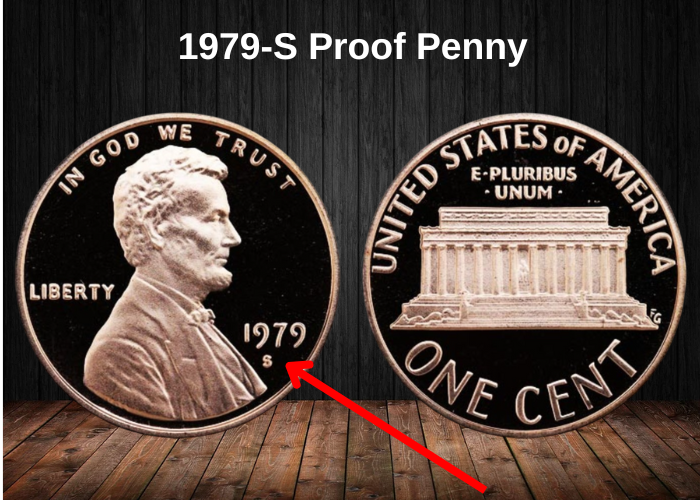
By 1979, Proof Lincoln Cents had fully transitioned into the modern era of coin production. Rather than using acid pickling to create frosted design elements, the U.S. Mint began employing computerized laser technology. This technique offered more precision and durability, producing Deep Cameo (DCAM) finishes with lasting contrast between the frosted devices and mirror-like fields. On earlier acid-washed proofs, the frosted effect diminished with each strike — a flaw lasers resolved.
The dies were also meticulously polished using horsehair brushes to enhance reflectivity, while the planchets (coin blanks) were burnished in stainless steel media. These combined treatments gave 1979 proof pennies their distinctive sharp and lustrous appearance.
Mint Mark Varieties
Proof pennies from 1979 were struck at the San Francisco Mint, with a total mintage of 3,677,175 coins. These bear the “S” mint mark, which appears in two styles:
- Type 1 (Filled-S)
- Type 2 (Clear-S)
The mint marks were applied manually as the final step in die preparation.
Type 1 – Filled-S Proof Penny
Most 1979-S Proof Pennies feature the Type 1 Filled-S mint mark. A pristine PR 70 DCAM example sold for $10,925 in 2003. However, the population of such coins has since grown, with almost 40 known examples. As a result, their value declined to about $2,700 as of August 2023.
Lower-grade examples are more common:
- PR 69 DCAM: Over 3,000 graded — worth approximately $20
- PR 65 DCAM: Even lower in value, often under $5
Type 2 – Clear-S Proof Penny
The Clear-S (Type 2) variety is scarcer, though exact mintage figures are unknown. A top-grade PR 70 DCAM sold for $3,819 in 2013, but with 33 examples now graded at this level, the value has dropped to around $1,350 (as of August 2023).
Lower grades include:
- PR 69 DCAM: Over 2,500 graded — valued at $22
- PR 65 DCAM: Typically sells for $5 or less
These coins continue to attract collectors for their craftsmanship, historic transition to laser frosting, and subtle mint mark distinctions.
Rare 1979 Penny Errors List
1979 Penny Cud Die Break
Steel dies used in minting coins are costly to produce, so the U.S. Mint utilizes them for as long as possible. As these dies age, they begin to crack or chip, and these imperfections are then transferred onto the coins they strike. These flaws are known as die breaks, and when they occur near the edge of a coin, they are specifically referred to as cud breaks.
On this particular 1979 Lincoln Cent, the cud appears on the lower right of the coin. While technically a minting error, such features are highly sought after by collectors. This example, graded MS 64 BN (Brown), sold for $1,020, showcasing how certain die defects can significantly enhance a coin’s value.
1979 Penny Struck Thru Fragment Cap Die

When a foreign object or material comes between the die and the blank during minting, it’s known as a strike-through error. However, some strike-throughs are more unusual and valuable. One such case is the die cap error.
This happens when a blank sticks to the die after being struck, effectively covering it and blocking the design for the next coin. The coin struck beneath this “cap” is called a brockage error and usually shows a blurred, incomplete, or mirrored design.
In this example, the coin—affected by a brockage error—was graded AU 55 (About Uncirculated) and sold for $1,200, reflecting both the rarity and collector interest in dramatic minting anomalies.
1979-D Penny Deep Obverse Die Cap
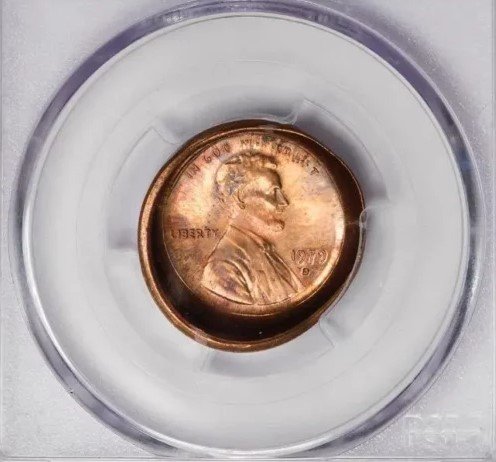
We just explored what happens with a partial die cap, but here’s a more dramatic example. In the previous case, only part of the design was affected, resulting in limited distortion. However, in this instance, the upper coin completely covered the obverse die, causing the next coin to be struck with no reverse design at all.
This full die cap error caused the coin to take on a deeply cupped shape, with a sharply distorted obverse and a smooth, blank reverse. Meanwhile, the brockage coin struck beneath it likely ended up with no obverse (heads) side.
Graded MS 64 RD, this dramatic mint error sold for $329, showcasing how extreme striking anomalies can command solid value in the market.
1979-D Penny Struck on a Dime Planchet
Sometimes, pennies are mistakenly struck on blanks intended for other coins. In this case, a 1979-D Lincoln Cent was minted on a dime planchet, which is slightly smaller (17.91mm vs. 19.05mm) and has a distinctive silver tone. It also weighs less—2.3g compared to the usual 3.11g of a penny. This error is easily noticeable and, in MS 64, sold for $1,260.
1979-D Penny Off-Center with Triple Curved Clip Error
Coin blanks are punched from large metal sheets, which sometimes leads to clip errors when leftover scrap metal is mistakenly struck. This penny features three curved clips, a result of the blank being struck near punched-out holes. Combined with a noticeable off-center strike, this rare error sold for $129 in MS 64 RB.
1979-D Penny Strike-Through Error
Strike-through errors happen when foreign objects come between the die and the blank during minting. In this example, a thin piece of fabric left a raised, textured stripe running diagonally across the coin—from just beneath “In” to over the “ER” in “Liberty.” Graded MS 60 RD, this unique coin fetched $111.
1979-D Penny Double Struck Off-Center Error
Double strikes occur when a coin is struck more than once—but if the planchet shifts between strikes, the result is a dramatic visual error. This penny was double struck and off-center by 25% and 85%, creating a strikingly misshapen design. In MS 66 RB, it sold for $312.
1979-D Penny Indent Errors
Indent errors happen when a foreign object partially overlaps the coin blank during striking, creating a sunken imprint. One penny that was 25% off-center and featured double indents sold for $169. Another, with a similar obverse indent and overlapping strike, graded MS 64 RB, went for $234.
Where to sell your penny?
Now that you know the value of your penny, you might be wondering where to sell it. Don’t worry: here’s a guide to some of the best online platforms where you can easily sell your coins, along with their advantages and disadvantages.
Discover the best platforms for selling coins online (pros and cons).
1979 Lincoln Penny
1. How did rising copper prices and inflation affect the 1979 penny’s intrinsic value?
In the late 1970s, copper prices surged, causing the melt value of copper-based pennies to approach or exceed one cent. This raised concerns about the cost-effectiveness of minting copper coins, ultimately leading to the transition to copper-plated zinc in 1982. The 1979 penny thus represents one of the final years of full-copper composition during a critical economic turning point.
2. Are there notable differences in strike quality between the 1979-D and 1979 (no mint mark) pennies?
Yes. Denver-minted (D) pennies are generally known for having stronger strikes and better overall detail. In contrast, Philadelphia-minted coins (no mint mark) sometimes exhibit weaker strikes or planchet flaws. This makes 1979-D coins more desirable for high-grade condition sets, while Philadelphia issues may appeal to error collectors.
3. Why are MS67+ Red examples of the 1979 penny considered rare despite high mintage?
While billions were minted, most 1979 pennies entered circulation and suffered wear or discoloration. True MS67+ Red (RD) examples require flawless surfaces, full luster, and sharp strikes. Because they are hard to find in such pristine condition, third-party grading adds significant value—sometimes turning a 1-cent coin into a $100+ collectible.
4. What distinguishes a full red (RD) 1979 penny from a red-brown (RB) or brown (BN) one in terms of market value?
Color designation is critical in Lincoln cents. A Red (RD) coin shows 95%+ original copper color, making it the most desirable. Red-Brown (RB) coins are partially toned, while Brown (BN) coins are fully oxidized. A Red 1979 penny in high grade (MS66-MS67) can be worth 5–10 times more than its Brown counterpart.
5. How did minting technology in 1979 influence die life and coin appearance?
By 1979, the U.S. Mint used high-speed presses and harder dies to meet massive demand, but die deterioration was still a problem. This led to features like die fatigue, flow lines, and even minor doubling. Coins struck early in a die’s life are generally sharper and command a premium.
6. Can die varieties or anomalies on 1979 pennies serve as reliable indicators of minting practices at the time?
Absolutely. Minor anomalies such as Repunched Mint Marks (RPMs), die cracks, or misaligned dies on 1979 cents offer insight into the mint’s die maintenance and quality control. Collectors study these to understand the evolution of minting standards and to catalog unique pieces.
7. Why are proof 1979-S pennies of special interest to modern variety collectors?
The 1979-S proof penny was part of a transitional era in U.S. proof coinage. Though it doesn’t have the “Type 1/Type 2” variation like the 1979-S Susan B. Anthony dollar, the quality of frosting, cameo contrast, and strike clarity in proof pennies from this year varies enough to interest specialists. Deep Cameo (DCAM) examples in PR69–PR70 are highly sought after.


















































